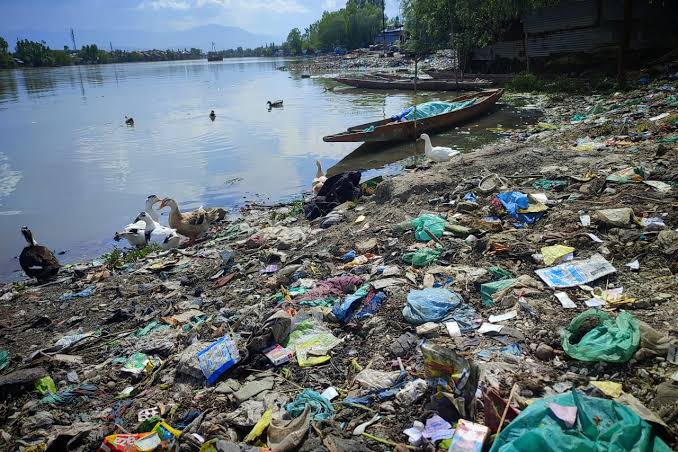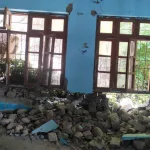Srinagar: The picturesque Jhelum River, once revered for its pristine waters and scenic beauty, is now grappling with severe pollution due to rampant waste dumping and untreated sewage.
Serving as a vital lifeline for the people of Kashmir, the river has long been a source of drinking water, irrigation, and hydropower. However, over the years, it has become a dumping ground for garbage and plastic waste, raising serious concerns about its deteriorating health.
The river, which originates from Verinag in south Kashmir and flows through Srinagar before entering Wular Lake in north Kashmir, has witnessed a drastic decline in water quality. This decline is largely attributed to the unchecked disposal of waste by both commercial and residential establishments. Despite its crucial role in sustaining the region’s population, the river has been left neglected, with little to no effective waste management or pollution control measures in place.
These commercial activities, particularly in areas like Habba Kadal and Ali Kadal, contribute significantly to the pollution, accelerating the river’s deterioration. Local businesses, including kirana stores, poultry shops, hotels, and restaurants, add to the problem, with solid waste, plastics, and other debris regularly dumped into the river, further contaminating its once-pristine waters.
“The improper waste disposal is wreaking havoc on the ecosystem and exposing us to health risks,” said Waqas, a resident of Ali Kadal. “The Jhelum has become the biggest drain in Kashmir,” added Mohammad Ashraf, a resident of Habba Kadal. “Waste from homes and shops flows into larger drains, and ultimately everything ends up in the river.”
Beyond the visible waste, the increasing presence of microplastics has become a significant environmental issue. Recent studies by the National Institute of Technology (NIT) Srinagar revealed alarming concentrations of microplastics in the river, primarily caused by improper waste disposal. These tiny plastic particles, ingested by aquatic organisms, can accumulate in the food chain, potentially causing harm to both aquatic life and human health.
In addition to microplastics, other environmental issues such as eutrophication are also taking a toll on the river’s health. Excess nutrients from untreated sewage and waste are depleting the oxygen levels in the water, making it increasingly difficult for aquatic species to survive. Over the past three decades, the native fish population has declined by more than 50%, significantly impacting local biodiversity.
The pollution has also led to environmental incidents, such as the “fish kill” in Chattabal Veer, where hundreds of fish were discovered struggling for oxygen due to the high biochemical oxygen demand (BOD) in the water.
The pollution levels, particularly the high biochemical oxygen demand (BOD), were also confirmed by the Central Pollution Control Board (CPCB) in 2022, which identified the Jhelum as one of the most polluted water bodies in the region. CPCB data revealed that the entire stretch of the river from Srinagar to Baramulla is contaminated, with the BOD level recorded at 7.8, placing it in the priority class four.
In addition to the water itself, the riverbanks have also become a dumping ground. Despite regulations prohibiting waste disposal, local vendors and shopkeepers continue to discard waste along the banks, further aggravating the river’s degradation. While a 2019 high court ruling mandated authorities to address the issue by preventing waste dumping and improving sewage management, enforcement of these measures has been insufficient.
“People are openly dumping waste along the banks, worsening the situation,” said Ishtiyaq Ahmed, a shopkeeper. This has not only affected the river’s aesthetic appeal but also its ecological health.
To tackle the growing issue of waste disposal along the riverbanks, the Srinagar Municipal Corporation (SMC) has implemented several measures to alleviate the problem. The SMC has deployed Hooper vehicles to collect garbage and other waste from commercial establishments. “These vehicles operate twice daily,” said a senior SMC official requesting anonymity. “Additionally, the SMC conducts regular awareness campaigns, such as jingles, to inform the public about the issue and discourage waste disposal in the river,” he added.
However, the situation remains challenging due to the lack of adequate sewage treatment plants (STPs). While seven STPs have been installed around Dal Lake, the Jhelum River, which flows through these areas, still lacks similar facilities to handle the increasing sewage levels.
“We are in the tendering process, and STPs will be set up soon,” said a senior official from the Urban Environmental Engineering Department (UEED), requesting anonymity.
With pollution levels rising and insufficient measures in place, the Jhelum is at a critical crossroads. Without immediate and comprehensive action, the river faces the risk of irreversible damage, endangering the livelihoods and public health of thousands across the region.







